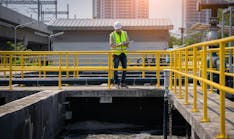There are many moving parts when it comes to operating a business. Not only do you need to ensure that you’re making a quality product and saving costs - you also should be making decisions that are beneficial to your community and the world at large.
Sustainable wastewater treatment is not necessarily the first area most companies turn to for new ideas. However, it’s a process that can improve business operations while helping your business address climate issues and become a better steward of water. New wastewater treatment technologies offer solutions that reduce energy consumption and increase the quality of water you are discharging.
The main reason companies like yours invest in onsite treatment is because they are facing high costs from the utility or trucking, or have permit levels that require industrial pretreatment before discharging. Typically, sustainability doesn’t make the list of reasons, and there are many reasons why companies don’t want to install onsite treatment, namely it is not their core business and it takes time, money and specialized knowledge to operate it.
But just how can you improve wastewater treatment processes and increase sustainability? Let's look at the current technologies for treatment and some of the sustainable solutions available.
Today’s technology solutions
Wastewater treatment hasn’t changed much in the past 50 years. For biological based treatment, there are variants, but they are all based on aerobic and anaerobic processes.
Aerobic processes
Biologically treating wastewater requires oxygen to fuel decomposition. The bigger your facility and the more wastewater streams you create, the more oxygen the on-site treatment facility will need; otherwise, treatment will either slow down or require an increase of power and overall time to process said waste. Both of these result in the overall system decreasing its efficiency, thereby increasing costs.
Anaerobic digestion systems
Anaerobic digestion uses microbial communities to remove organic matter without oxygen. Fun fact: while there have been many advances since then, the first anaerobic digester was actually installed in India in 1859 in a leper colony.
Many modern on-site wastewater treatment facilities use anaerobic digestion in some form. A low-cost form of anaerobic digestion is the use of anaerobic ponds in which wastewater is dumped into a hole as it would be in a landfill and left fully to biological processes to solve. However, agricultural industries and large industrial plants have more commonly incorporated anaerobic digestion because of the significant side-benefit of generating a type of methane known as biogas which can be captured during the treatment process and used as an energy process.
Because the system itself creates and captures energy, anaerobic digestion systems offer sustainability benefits to companies, as the biogas can offset power demand for the facility and help meet greenhouse gas commitments.
Choosing a new solution
As you start to consider your alternatives, let's take a quick look at the steps every business can and should take if they are considering investing in onsite treatment.
- Know your wastewater — Are you a beverage plant that has alcohol going down the drain or an agricultural facility dealing with animal waste? This will determine what solutions will help you achieve your treatment goals. Begin by knowing what is going down your drain. This also includes understanding what wastewater is generated from different steps in the process, as there could be opportunities for segregating or side-streaming specific flows to improve the design and operation of the system.
- Know why you are doing it — While this seems obvious, there could be different reasons for investing in wastewater treatment, and these could have very different outcomes. Is it to reduce costs, increase sustainability, meet permit compliance (now or in the future), or to accommodate future growth. Understand what your medium and long term goals are with regards to plant expansion, as you don’t want to build an onsite treatment plant that can’t grow with your company's growth.
- Work with your utility — Whether it is a discussion about future infrastructure plans that they are making, high surcharges, or whether you are investing in industrial pretreatment, it’s important to engage proactively with the utility.
- Find the right partner — There are many engineering consulting firms that are very experienced in designing onsite treatment plants. It is likely that they have seen other companies with your challenges and can bring that experience to help you avoid mistakes in over designing or putting in place a system that doesn’t meet treatment objectives.
Orianna Bretschger is the CEO and Founder of Aquacycl. Aquacycl treats complex industrial wastewaters to support healthy watersheds. The company helps industrial companies achieve their climate, water and business goals by providing wastewater treatment as a service that guarantees permit compliance and mitigates up to 90% of greenhouse gas emissions.



